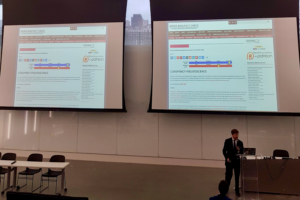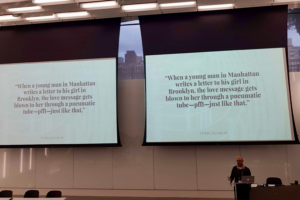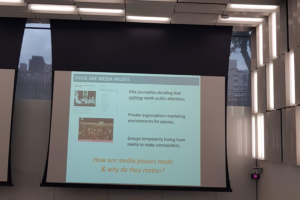Earlier this autumn I got the chance to attend Speed, an event organized by Cornell Tech. The two-day conference focused on the dimension of speed that comes along, together with scale and complexity, when talking about algorithmic oversight. Speed is also another important aspect of the way algorithms impact our lives, even though we might not think about it that often, now we got used to getting so many things so fast. But as the event description narrows it down, “when an algorithm acts so much faster than any human can react, familiar forms of oversight become infeasible”.
Even though I could only see a few of the presentations, I am going to briefly highlight some of the ideas that I found very interesting. You can check the entire schedule and the full presentation here.
- James Grimmelmann from Cornell Tech had a lighting presentation on moderation and memes. Going from media bias and fact checking, virality and social media trends, he discussed the concept of speed through the growing (and risky) popularity of memes. For example, he asked what makes memes take off so fast. Ambiguity might be one of the answers, a characteristic which, among velocity or controversy, defines the memes culture. A growing phenomenon which might get difficult to moderate and that does not always spread humor, but it can also spread hate speech or offensive messages. After the presentation I got this stuck in my mind: how can we train algorithms make the distinction between humor and, let’s say, extremely racist discourse? Is our technology able to notice the fine line? When is it a “fine” line?

- Next, I listened to Kate Klonick’s preview on her latest article, “Facebook v. Sullivan”. Now the article is online and I highly recommend you to check it out, especially if you are interested in content moderation, or how equity can be reshaped by social media’s moderation practices. The article debates “Facebook’s moderation of user speech, discussing how and why exceptions for public figures and newsworthiness were carved out”. For example, I was surprised to find out how Facebook manages “bullying”, for example, in terms of content moderation. Just to put it very simply, and not in legal terms: when it comes to public figures, rules are not the same as with regular people. Meaning that Facebook protects more the people who supposedly do not have the power or tools to protect themselves from being bullied, or addressed offensive speech. It might seem legit so far; but the problem is that Facebook relies on online news sources and news aggregators to make public figure determinations. And what if, for example, a person’s name gets in the news after being the victim of a burglary or violence, let’s say, and there is a lot of content out there mentioning his name and identity? That person is definitely a public person. But it might be considered one, and this is where the lines get blurry. Nonetheless, the article is way more complex and you should definitely check it out!

- Jason Farman’s presentation, “A History of the Instant in Media and Message Exchange” was also related to the subject of his latest book, Delayed Response: The Art of Waiting from the Ancient to the Instant World. A book I did not get to read, but which is on my list for sure. I loved how he went back to the idea of communication between individuals and how the medium is supposed to help, and not alter their messages. But does it alter it? That’s a tough question, for sure. Nonetheless, whenever you feel like the time from getting a “seen” after you have just sent a message and the reply is too long, remember about the New York City’s pneumatic tubes that carried letters throughout the city. “Each tube could carry between 400 and 600 letters and traveled at 30-35 miles per hour”, and “It took between 15 and 20 minutes for mail to get from Herald Square to Manhattanville and East Harlem”, says this website — sorry, during the conference, I was fascinated with the photos of the tube and I forgot to take write down this kind of stats :). So was that also an instant messaging service?

- I also checked Mike Ananny’s presentation “Public Pauses: Sociotechnical Dynamics of Temporal Whitespace in the Networked Press”. It came as a great continuation of the talk he had had one day before at Databites, at Data & Society, where he was in conversation with Tarleton Gillespie and Kate Klonick (you can watch the video recording here) At the beginning of the presentation, he reminded the audience about the BBC’s famous “There is no news” from 1930, in order to introduce the concept of media pauses. He further asked what are media pauses and why do they matter, especially nowadays, in a networked press (a concept he develops at large in his latest book, Networked Press Freedom Creating Infrastructures for a Public Right to Hear). By discussing whitespaces, and what does a journalistic pause mean in different situations, he states: “if you look for them, absences are everywhere. Whitespace is never nothing. It’s relational, and evidence of something”. And this let me thinking about how do users perceive media pauses today, in a continuous flux of information. Do people even notice media pauses?
PS: Sorry for the quality of the photos. I did not even know I was about to use them here.
This site (thehashtags.commons.gc.cuny.edu) is not an official site of the Fulbright Program or the U.S. Department of State. The views expressed on this site are entirely mine and do not represent the views of the Fulbright Program, the U.S. Department of State, or any of its partner organizations.

